"Think you can't cook scallops? Thai? This recipe for Thai Curry Scallop with Spinach and Rice Noodle is an extremely easy and tasty dish that will make your Thai-food loving and scallop-loving guests swoon.
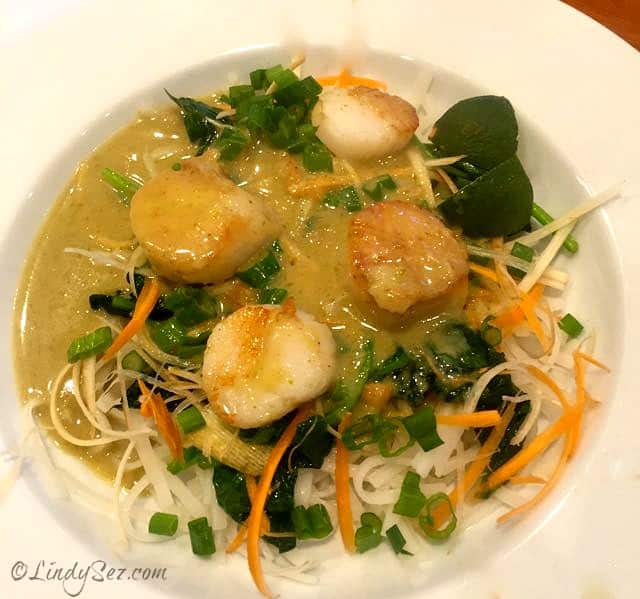
The making of Thai Curry Scallops with Spinach and Rice Noodles
I may have mentioned in previous posts, at least once, or twice, or six times, that BB LOVES scallops. He says he could eat them every day of the week and never get tired of them.
And that's a good thing.
Scallops are quick and easy to prepare - low in fat and calories - and one of the "best" kinds of seafood you can consume for your good health - according to Seafood Watch.
Easy to prepare I dare say?
Yes, easy to prepare, and prepare perfectly.
As I travel and talk with people I find one of the most common comments I get when talking "scallops" is, "I love to eat them in a restaurant, but am afraid to cook them at home - they never seem to turn out right - too rubbery".
"A scallop done well, is a scallop not well done."
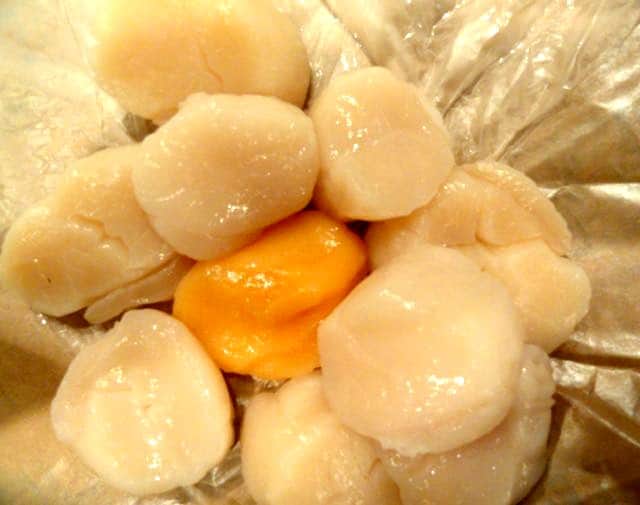
How to cook a Scallop to perfection
One of the most important steps to the proper cooking of a scallop - it must be dry and cooked in a hot pan. A scallop not dried properly, or a pan too cool, will make the scallop simmer, not sear. While a simmered scallop may not look as nice as a seared one, it is edible and quite good, however, you will probably overcook it trying to get it browned and beautiful, so dry your scallop well before putting it into the hot pan. (There is an exception to this rule, which I will explain in a future installment of scallop love.)
Fresh or Frozen?
I think fresh is always best. But frozen is not second best, only not as best as fresh.
Fresh generally needs a bit more work. With either fresh or frozen, you have to remove the muscle where the scallop attaches itself to the shell. It's pretty easy to locate on said scallop, it looks a different color, AND has a different texture. Use a knife and gently remove this muscle. It should just come right off, no cutting necessary.
If the scallop is frozen, thaw it. Some days, when I plan ahead, I take my frozen scallops out in the morning, put them on a plate, and stick them in the refrigerator to thaw all day. By dinnertime, they are pretty much done. On days I don't plan so well, leave the plate on the counter for about an hour and the job is once again done. You might find an ice "shield" formed, just remove that. OR, you could run under cold water to thaw, but I find that removes much of the scallop flavor. Not my best recommendation for thawing, but it does work.
Next, if fresh, rinse the scallop in cold water to remove any sand or grit. If frozen, this is generally already done.
Now, dry the scallop well. I mean really really well. A wet scallop is a seared scallops worst enemy.
Cooking your scallop
Most scallops, fresh or frozen, are about ¾ to 1 inch thick. This is great for "quick cooking". So quick cook them by heating your pan (a well -seasoned cast iron pan is perfect for seared scallop), get your oil hot, then add the scallop(s) making sure not to crowd your pan. I use the "clock" method of adding food to a pan to sear, especially when I have to cook quickly, adding the first scallop at 12:00 then 1:00 - 2:00, you get the picture. Once you have finished 11:00, you are probably about ready to turn 12:00 - work around the pan turning and then remove. It shouldn't be more than 2 - 3 minutes in the pan on each side, TOPS. Watch them closely. You can actually see the cooking move up the side of the scallop, once it gets ⅓ of the way - turn - the other third - remove.
Better and slightly undercooked scallop than a well-done scallop. Cook only to opaque.
Please for the love of scallop.
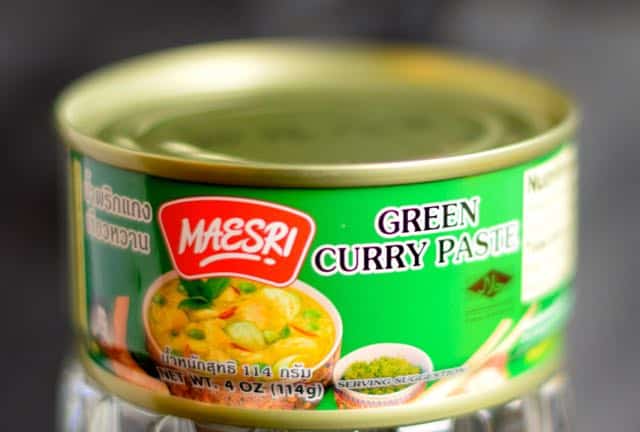
Curry Paste
Choices for Thai curry pastes may be limited in grocery stores, but there are many brands of Thai curry pastes available in Asian markets, and online. Since I've discovered Maesri curry pastes, my search is over. The pastes are well balanced, quite inexpensive, and show a good amount of heat. They make the paste in green, red, and yellow. Green or red work with this dish. (You can find these in many Asian markets or online.)
Do keep in mind, these are not mild pastes, so if you are not into hot foods, add less than I say in the recipe and adjust once it's done.
You can, of course, if so inclined, make your own - or use another brand you love already. Just add and use to your own taste.
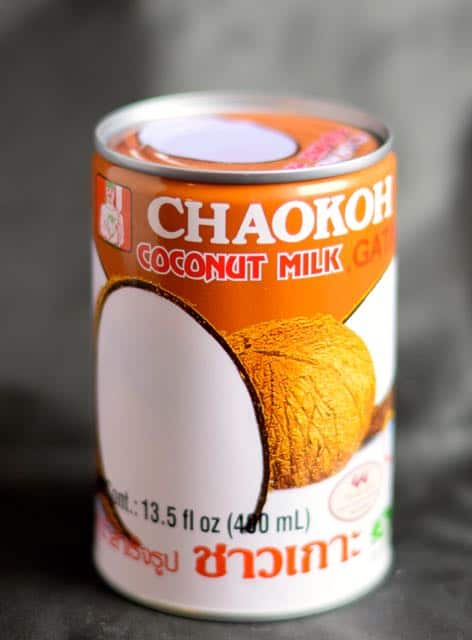
Coconut Milk
Not all coconut milk is created equal.
Really?
Yes, really.
While I love many of Trader Joe's products, their coconut milk, light or regular, sucks donkey balls. With every can I opened, thinking of course that the last one was just a fluke, the fat is sitting at the top. No amount of shake - shake - shake helps. It does not homogenate. You really have to put it into a blender to get it to mix. So don't go there.
I like Chaokoh for its rich, creamy mouthfeel. It's what almost all the fine Thai restaurants in the area use, and when bought at an Asian market, is really quite reasonably priced. My second choice is easily found in almost all grocery stores, and that's Thai Kitchen.
Full fat or low fat?
Since I've been doing research on what they do to products to make them low-fat, or reduced-calorie, or whatever you want to call "healthier", I'm finding the additives they use really makes it less healthy than just going for the full-fat version and eating less of it. Coconut is considered a "healthy" fat and I don't use it every day, so I'll just go for the real thing. You can choose low-fat if you so choose.
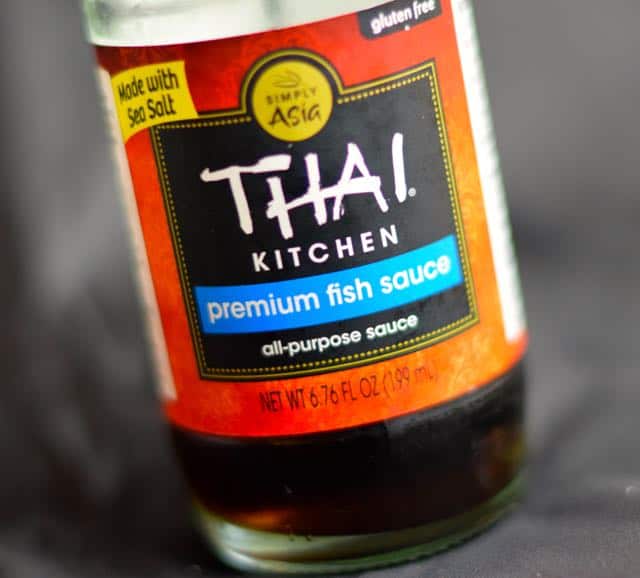
Fish Sauce
Someone said to me the other day, "I love cooking Thai food - you can always adjust it by adding a little more fish sauce, or a little more lime juice" and that, with sugar, is exactly right. Thai food is a balance of salty (fish sauce), sour (lime juice), bitter (lime peel), and sweet (sugar). When tasting the final dish, you can easily adjust any of these components.
Thai Kitchen is a fine fish sauce that is sold in almost any grocery store. If you do have the option of going to an Asian market, you will find many many more choices, generally, in a language, you don't understand, but be willing to give them a try. ONE thing I do not recommend - smelling it. It stinks.
But tastes lovely.
The Veggies
Spinach is one of the world's healthiest foods. Even than kale! Yes, it's been around forever. It's not sexy. It's just good food.
Don't overcook it.
I put half in the pan and let it cook down a bit to make room in the pan for the rest of it, otherwise I find I'm throwing more spinach on the stove then I have in the pan. It looks like a lot but cooks down to almost nothing.
Putting it into the colander to drain helps keep the juices from seeping out when you plate. While spinach juice won't hurt the dish, just dilute the sauce a bit, it's not overly attractive so, drain it for a while after cooking.
I left the carrots, finely julienned, raw. BB and I both love the crunch it gave. I used a julienne peeler to get the shreds very fine.
The green onion I julienned as well, after cutting into 2-inch lengths. This is easily done by cutting them in half lengthwise, and simply slicing vertically down into a fine slice. I also did some tops, just for garnish.
Thai Curry Scallop with Spinach and Rice Noodle is complimented with a fresh, simple, Cucumber Salad.
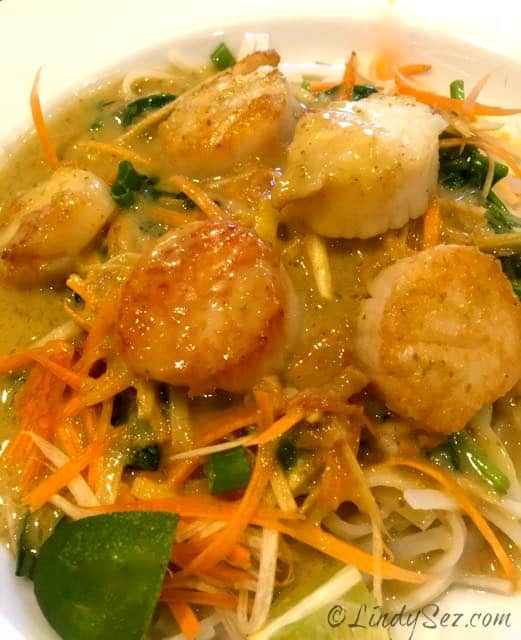
Thai Curry Scallop with Spinach and Rice Noodle
การรับประทานอาหารที่ดี
Kār rạbprathān xāh̄ār thī̀ dī
Here's to good eating - in any language.
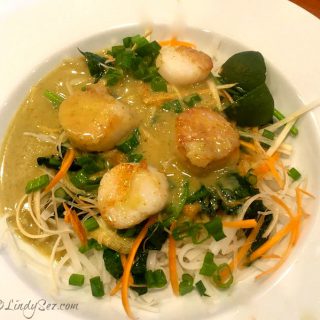
Thai Curry Scallop with Spinach and Rice Noodle
Ingredients
- 3 tablespoons coconut oil or peanut oil, divided
- 1 pound baby spinach large stems removed
- Salt
- 1 can 13.5 ounce coconut milk (I like Chaokoh or Thai Kitchen)
- 2 ounces ½ can Maesri Green Curry Paste or to taste (or your favorite Thai curry paste, to taste)
- 1 teaspoon sugar preferably palm sugar
- Zest of 1 lime plus 2 tablespoons fresh lime juice
- 1 tablespoon fish sauce
- 1 - 1 ½ pounds large sea scallop about 4 per person muscle removed, rinsed and patted dry
- 1 large carrot peeled and cut into a thin julienne (I used a julienne vegetable peeler)
- 3 green onions thinly sliced on the bias or sliced into 2-inch pieces then julienned
- 2 tablespoons finely chopped roasted peanuts or cashews
- Freshly chopped cilantro optional
- Torn Thai basil optional
- 8 ounces rice noodle prepared according to package directions
Instructions
- In a large skillet heat 1 tablespoon of the oil; add half the spinach and cook over moderately high heat, tossing with tongs, until slightly wilted, add the remaining spinach and toss and cook until wilted. Season with salt and transfer to a colander to drain.
- In a small saucepan, combine the coconut milk, curry paste, sugar, lime zest and juice, and fish sauce - whisk to combine. Heat over low heat until simmering, cook, stirring occasionally, for about 10 minutes. Taste and adjust seasonings (and heat). Keep warm.
- Wipe out the skillet used to cook the spinach. Over a fairly high heat, heat the remaining 2 tablespoons of oil. Lightly salt and pepper the scallop on both sides, place the scallops in the pan, in batches if necessary to not crowd the pan, you want sizzle, not steam, cook about 2 minutes per side. Set-aside cooked scallops while you finish remaining ones.
- To AssembleI: n a large wide bowl, place the rice noodles, split the spinach evenly over each dish, then the carrot and onions, top with cooked scallops, then pour the curry sauce evenly over each bowl. Top with chopped nuts, and optional cilantro and/or Thai basil. Serve immediately.

Leave a Reply